A webinar marketing strategy is as much an art as it is a science — albeit with a few best practices that apply in most scenarios. This post will walk you through 14 examples of successful webinars that you can draw inspiration from when hosting your own webinars.
NOTE: Our webinar platform, eWebinar, only supports pre-recorded webinars. However, this list will feature examples of both live and on-demand webinars to ensure you get value regardless of which format you ultimately decide on.
Let's dive in!
Best practices to run a successful webinar
Click here if you want to skip straight to the examples!
The best webinar examples combine multiple best practices to get the best results.
Here are six best practices to help you run the best webinars possible:
1. Audience research
Doing your homework will help you align both the webinar topic and webinar format (i.e. live webinars vs on-demand access) with your target audience. Too many webinar hosts skip this foundational step and end up putting time/effort/money into misaligned webinars that don't get traction.
A few ways to hone in on your target audience include:
-
Interviewing your customers
-
Surveying previous webinar attendees
-
Seeing which audiences your competitors are targeting
There are also industry-specific research methods. For instance, a SaaS company may be able to look at its product metrics and user segments to identify specific personas that they could aim their webinars toward.
Tip: Use webinar surveys to gather further insights from your registrants and attendees before, during, or after the presentation.
2. On-demand access
Making your webinars available on demand will turn one-time virtual events into evergreen assets. To get the best results, you should plan the event as on-demand from the start and choose an evergreen topic in accordance with that.
There is some value to uploading the replay of a live webinar — such as giving registrants who missed the event a second chance to watch the presentation — but it’s a lot easier to create an engaging attendee experience when you build on-demand webinars from the ground up.
Certain webinar formats lend themselves to on-demand access while others are less suitable.
An example of the latter would be a panel discussion webinar since the live conversation and real-time access to experts is what makes panel discussions special. However, any presentation that you host over and over again — such as sales/product demos, onboarding/training, etc. — can and should be automated.
To learn more, read our full guide on Should You Do Live or Automated Webinars: How to Get the Best Results!
Note: On-demand webinars also eliminate the need for a backup internet connection or uninterruptible power supply since the presentation is pre-recorded and thus immune to the technical difficulties of live events.
3. Choosing the right software.
Which webinar platform you're hosting webinars on also plays a role. When vetting software, make sure the solution you choose has the necessary features and supports your webinar format. You should also decide between live or pre-recorded since the automation on hybrid platforms is often an afterthought.
Popular live webinar platforms include:
-
ClickMeeting
-
Livestorm
-
BigMarker
-
Zoom
-
GoToWebinar
Popular pre-recorded webinar platforms include:
-
eWebinar (that's us!)
-
Demio
-
EasyWebinar
-
WebinarGeek
-
EverWebinar
To learn more, read our full guide on the 10 Best Webinar Platforms!
4. Email sequences
Most people think of webinar emails in the context of email marketing and blasting invitations to potential customers/attendees. However, email sequences can also be leveraged to increase attendance by inviting existing audiences, reminding registrants, and surveying attendees.
There are four types of emails to include in your webinar sequence:
-
Invitation. Invitation emails are a great way to promote your webinar to existing audiences such as newsletter subscribers. Be sure to include key details like the topic, format, time, and date of your webinar — as well as the presenter(s) hosting it.
-
Confirmation. Confirmation emails do the important job of letting registrants know that their registration was successful. They also give registrants a chance to add the event to their calendars to ensure they don't forget about the webinar they signed up for.
-
Reminder. Reminder emails are arguably the most important part of the sequence since they keep the event top-of-mind to ensure that registrants follow through on attending. Sending a reminder one week before, one day before, and two hours before will prevent registrants from forgetting.
-
Follow-up. Follow-up emails give you the chance to collect feedback from those who attended your webinar, send replay links to those who missed it, and convert any leads that weren't ready to take the next step during the presentation itself.
To learn more, read our full guide on Effective Webinar Email Sequences!
5. High-converting landing page
You could host interviews with experts and produce interesting material but, if your landing page sucks, no one will bother signing up for the webinar in the first place. This is why optimizing your registration page is so crucial to running successful webinars.
Five best practices to build a high-converting webinar landing page:
-
Answer core four questions. The four questions a landing page needs to answer before someone will be ready to sign up for your webinar are: is this for me, who's behind this training, can I trust what they're teaching, and when can I watch? Your page must answer all four.
-
Craft a compelling headline. Your landing page headline and webinar title should be specific, list benefits, and create a sense of urgency. A good headline example would be "How to 2x Organic Traffic With On-Page SEO [Registration Ends Soon]" instead of "Content Marketing 101 (Webinar)".
-
Insert a bullet list agenda. Including an agenda in the form of a bullet list will give prospective registrants an idea of the topics you'll cover during the presentation. You should also touch on pain points and tease the benefits of attending (e.g. the problem being solved or the desired outcome).
-
Establish credibility. Getting people to sign up for your webinar is a lot easier when the host or presenters appear credible. Create author bios for each presenter with their name, role, company, headshot, and industry experience — as well as any relevant suffixes like CPA, MD, or PhD.
-
Have a clear CTA. Guide people to take the next step and register for your webinar. Include vital information like the time and date of the webinar. It's best to have this info "above the fold" so visitors don't have to scroll down to find it.
For landing page inspiration, review our curated list of 28 Webinar Landing Page Examples!
6. Attendee certification incentives
Incentives can be a powerful part of your webinar promotion strategy and offering a certificate is one of the most effective ways to get people to attend your presentation. This is particularly applicable for SaaS webinars where you can certify attendees as a product expert.
HubSpot, ClickUp, and Surfer are just a few examples of SaaS companies that offer certifications.
For more in-depth practical advice on webinar strategy, read our full guide on How to Create a Killer Webinar Strategy!
Successful webinar examples
Now that you're familiar with some of the best practices, it's time to get into 14 great webinar examples that you can use for inspiration. The list below contains entries from multiple industries across both live and on-demand formats!
Here are 14 examples of successful webinars:
-
HubSpot
-
Surfer
-
Neil Patel
-
Jon Schumacher
-
ActiveCampaign
-
Intercom
-
Later
-
Semrush
-
BigCommerce
-
Adobe
-
Hootsuite
-
Sprout Social
-
Everest Group
-
eWebinar
1. HubSpot
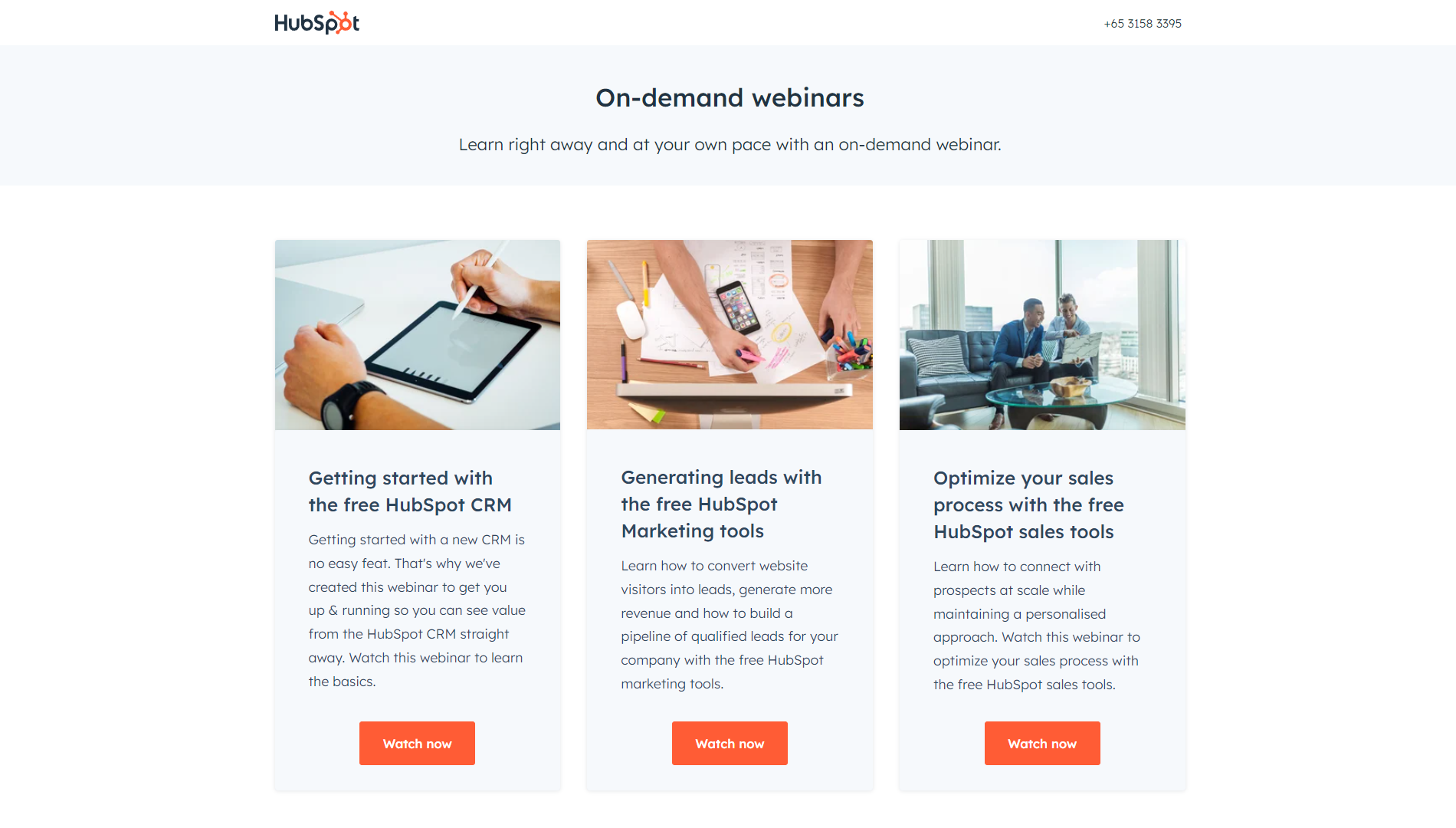
Source: HubSpot
HubSpot uses on-demand webinars to acquaint new users with their freemium CRM, educate customers on how to generate leads with HubSpot's tools, and show them how to optimize their sales strategy using the software.
In addition to product-specific presentations, HubSpot webinars also provide actionable advice on how to streamline sales, marketing, and customer service campaigns. Because the majority of their webinars are free to attend and available on demand, HubSpot is able to maximize reach.
Lastly, you have HubSpot Academy which offers certification courses for those who watch a collection of pre-recorded lessons from experts (usually around three hours in total). There's also an impressive level of variety within HubSpot Academy.
The marketing category alone has certifications for marketing automation, contact management, content marketing, email marketing, inbound marketing, lead generation, performance reporting, SEO, social media, and web design — not to mention all the training content on sales and customer service.
2. Surfer
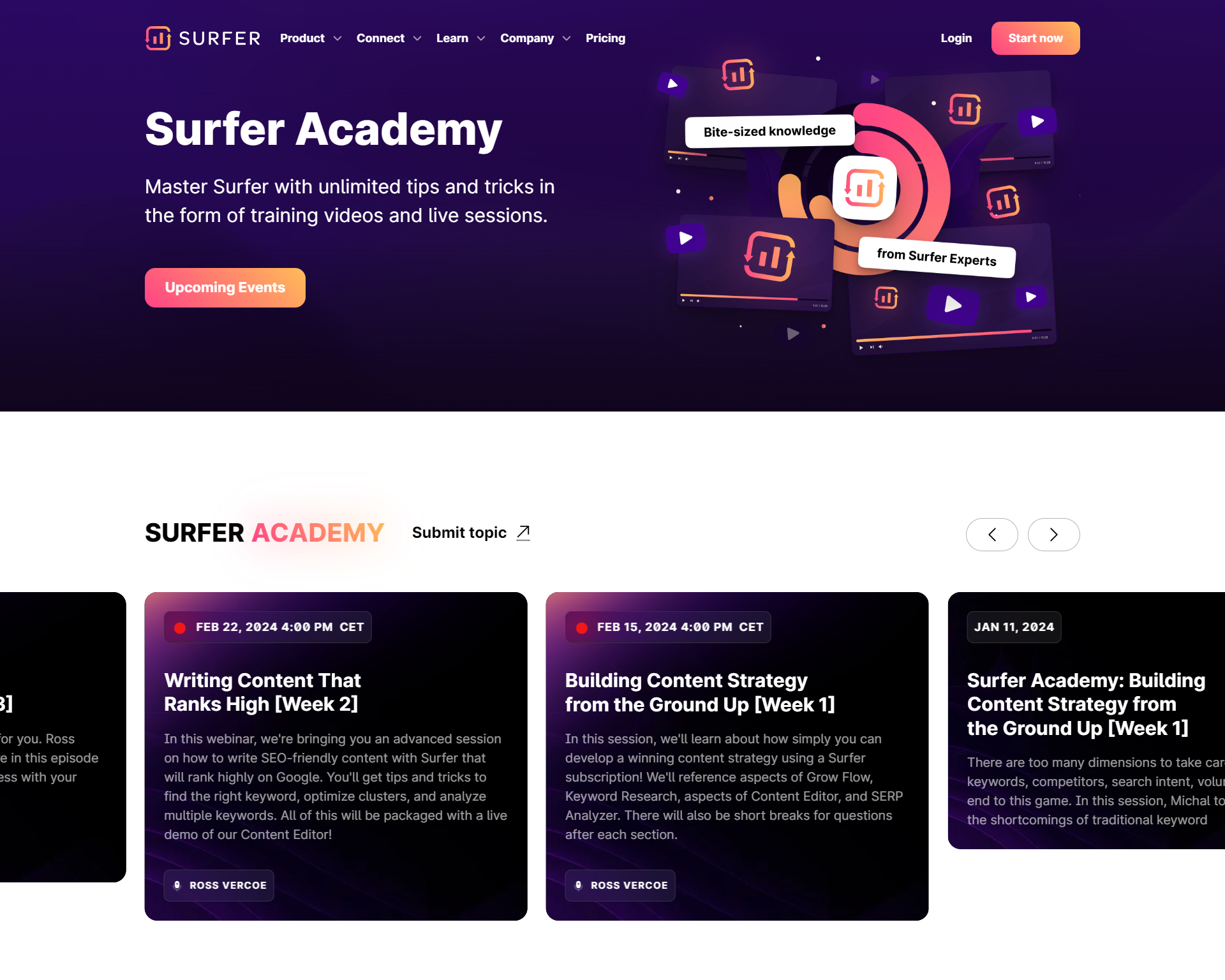
Source: Surfer
First of all, Surfer has a certification program that's popular within content marketing circles.
Our Director of Content at eWebinar actually completed the course before writing this article and vouched for the search engine optimization insights it provided. Specifically, the segments about on-page best practices and content clustering made for an accurate reflection of contemporary SEO.
It's important to realize that Surfer's certification program is just one part of the SaaS company's multi-channel webinar strategy. Surfer Co-Founder Michał Suski hosted a series of webinars on their YouTube channel a few years ago to spread awareness and educate customers.
There's also Surfer Academy where team members like Ross Vercoe and Danni Roseman host live webinars on a weekly schedule. As a bonus, the entire back catalog of webinar replays is readily available on Surfer Academy for anyone who wants to binge-watch past presentations.
3. Neil Patel
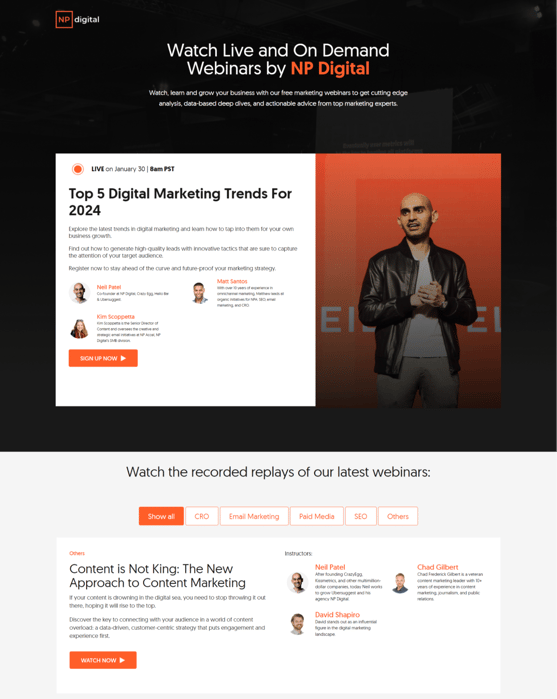
Source: NP Digital
Neil Patel, a popular figure in the digital marketing space over the past two decades and founder of heatmap software Crazy Egg, has utilized webinars to grow his personal brand as far back as 2014. Nowadays, Neil's webinars feature 1-3 co-presenters from NP Digital and some of his other companies.
His library of webinar replays also spans multiple categories including SEO, CRO, email marketing, paid media, and more. Neil uses a combination of his own track record and the industry experience of his co-presenters to maximize the credibility of each webinar.
The content itself consists of a healthy mix of recent trends and evergreen advice to increase short-term reach without sacrificing long-term traffic. Some of his online marketing webinars also utilize free tools that attendees can use for themselves after the presentation ends.
This shouldn't be surprising since Neil has historically used the free keyword research tool Ubersuggest to drive traffic to his website and accumulate backlinks. Overall, Neil Patel is living proof that webinars can be just as effective at building personal brands as they are for SaaS marketing.
4. Jon Schumacher
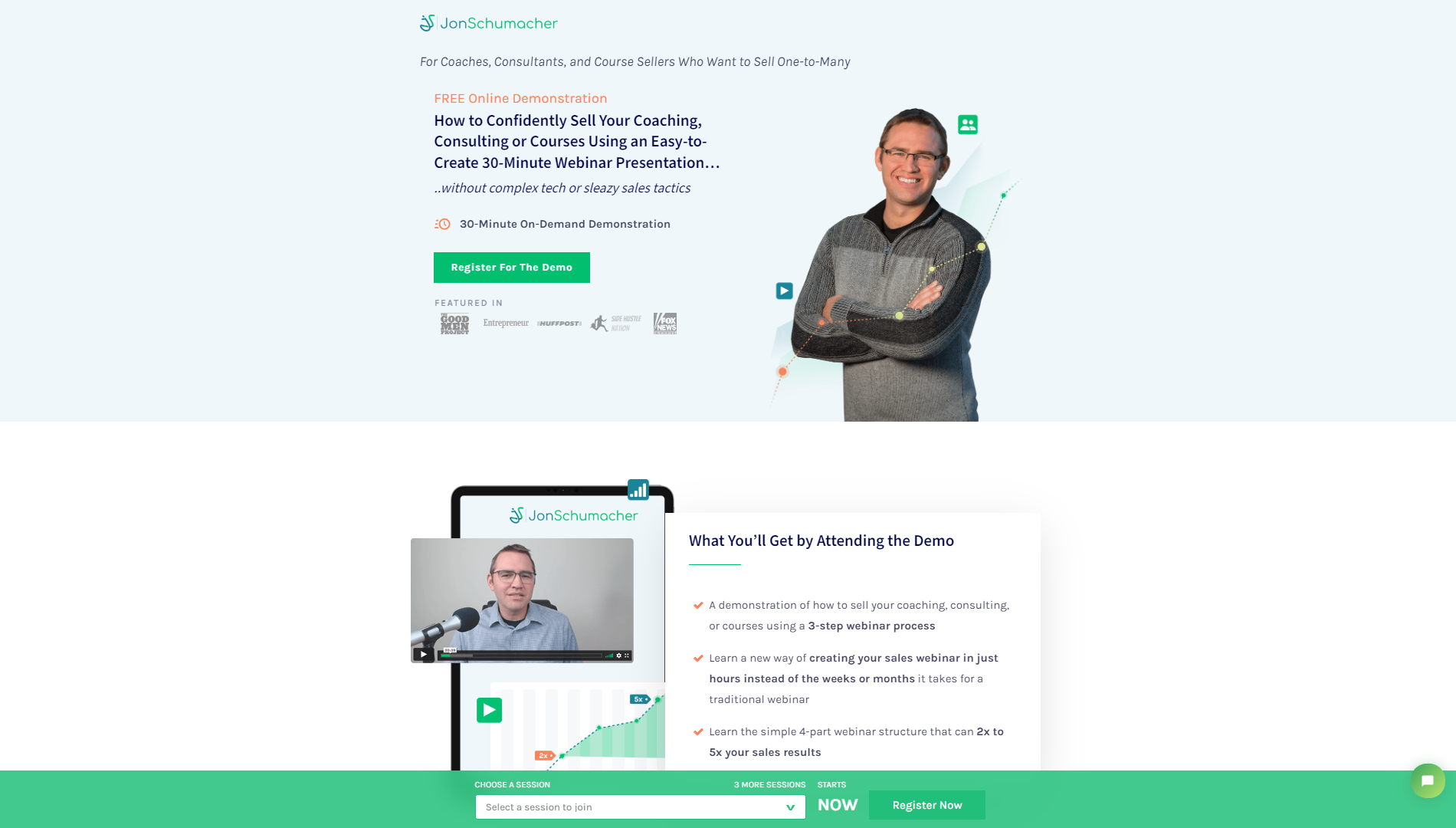
Source: Jon Schumacher
Speaking of personal brands, Jon Schumacher is a coach and consultant in the webinar space who practices what he preaches by using on-demand webinars to sell his courses. Because Jon's webinars are on-demand rather than live, they actually have the highest attendance rate on this list: 88%!
That means that for every group of 10 people who register for his on-demand demo, nine of them end up attending it. Jon was able to achieve such a high attendance rate by combining on-demand access with automated sessions that run on a recurring schedule.
This helps him capture leads who don't have the time to watch but want to sign up for a future session. On the other hand, anyone who's already keen to watch will be able to access the presentation immediately at their peak moment of interest.
Disclaimer: Jon uses eWebinar to host his webinars. To learn more about how he uses our software and the results he’s achieved, read the full case study!
5. ActiveCampaign
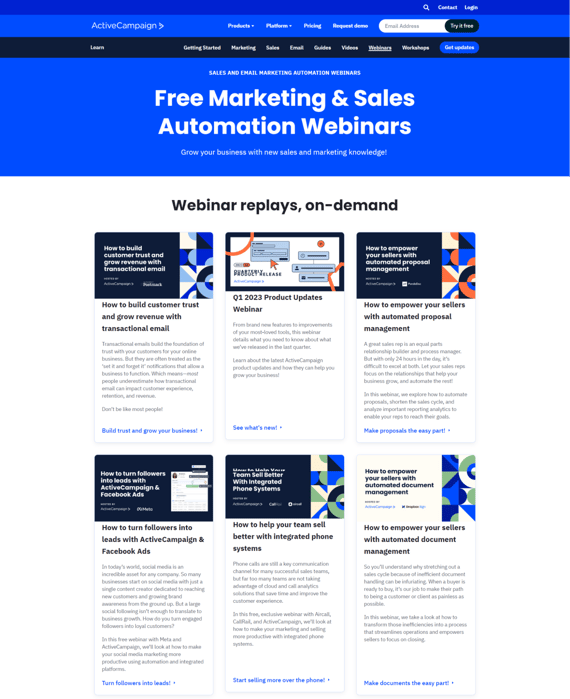
Source: ActiveCampaign
ActiveCampaign's webinar marketing strategy leans heavily on its catalog of on-demand replays. Much like Surfer and Neil Patel, ActiveCampaign offers on-demand access to their full library of webinar replays on topics like lead generation, email marketing, and sales automation.
In addition to replays, ActiveCampaign also has a newsletter that visitors can join to receive invitations to upcoming digital events. This helps them grow their mailing list with each webinar and run retargeting campaigns to promote future webinars to past attendees.
One unique tactic that ActiveCampaign uses is having different CTA text for each webinar replay:
-
Build trust and grow your business!
-
Start selling more over the phone!
-
Convert more visitors into leads!
-
Build your perfect landing page!
-
Build better emails, faster!
Above are a few of the action-oriented and benefit-centric CTAs ActiveCampaign hooks registrants in.
Tip: If you want to learn how to make an effective call to action during the presentation itself then read our full guide on How to Craft High-Converting Webinar CTAs!
6. Intercom
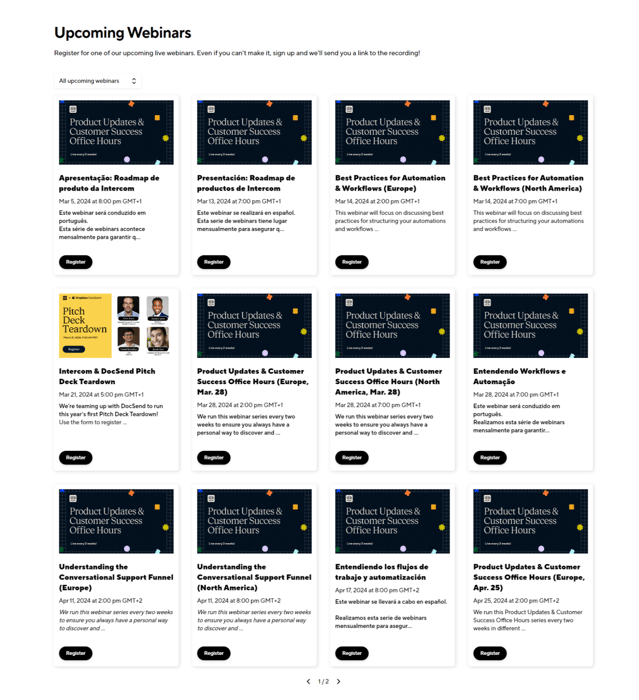
Source: Intercom
Intercom uses a combination of upcoming webinars, on-demand webinars, and in-person events to make it as convenient as possible for their community to attend. Their webinars primarily cover automation best practices, recent product updates, and customer support strategy.
In addition to English presentations, Intercom also hosts webinars in Spanish and Portuguese — going beyond the Anglosphere to reach audiences across Latin America. Their multilingual marketing strategy is a prime example of how to implement content localization in video form.
Tip: If you don't have the bandwidth to run webinars in multiple languages then consider trying some of the AI-powered video translation tools online (your mileage may vary).
7. Later
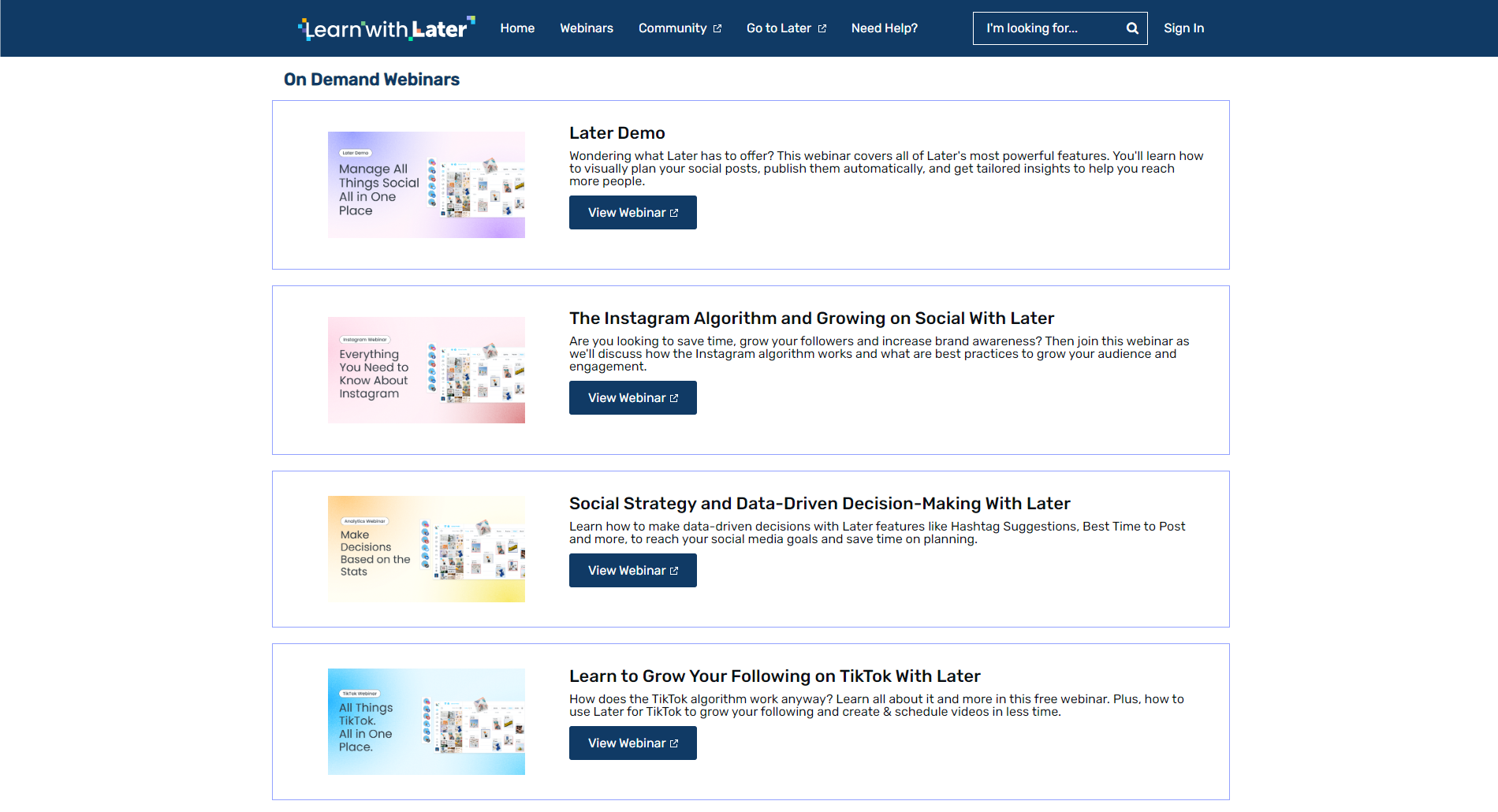
Source: Later
Later is an interesting entry on this list since they started out by hosting their user onboarding and customer training webinars live but then later switched to automated webinars with the goal of achieving scalability.
This led to a 50x increase in the number of webinars they run each month. Specifically, Later previously ran only a couple of live webinars per month whereas they now host over a hundred. In addition, webinar attendance has also increased 6x.
Because webinars are the primary means through which Later's customer engagement team educates users, automating this process has freed up a lot of time and given team members newfound bandwidth to work on more complex projects.
Disclaimer: Later uses eWebinar to host their webinars. To learn more about how they use our software and the results they’ve achieved, read the full case study!
8. Semrush
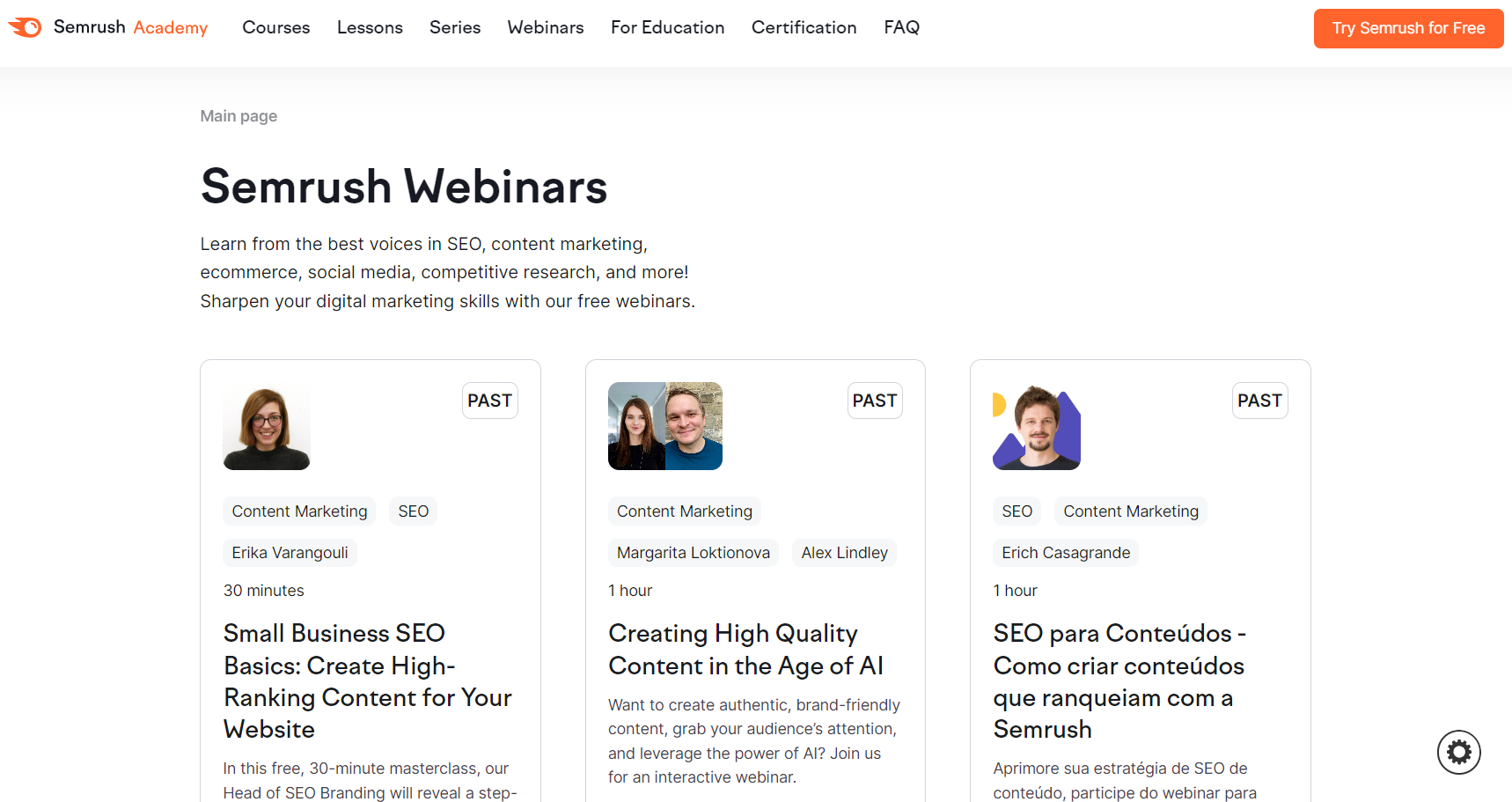
Source: Semrush
While Semrush is primarily known as a keyword research tool and SEO platform, its webinars include other areas of marketing like social media, content marketing, and career advice. There's also a handy feature that lets you filter between live/on-demand webinars and choose from five different languages.
The runtime for most Semrush webinars is around an hour — with the short runtime making the information more digestible for their audience. High-profile personalities from the SEO world like Brian Dean have also guested on Semrush webinars to share unique insights and boost credibility.
Note: At the time of writing, there's no indication that Semrush has upcoming webinars scheduled in the near future (but their back catalog of past webinars is still available).
9. BigCommerce
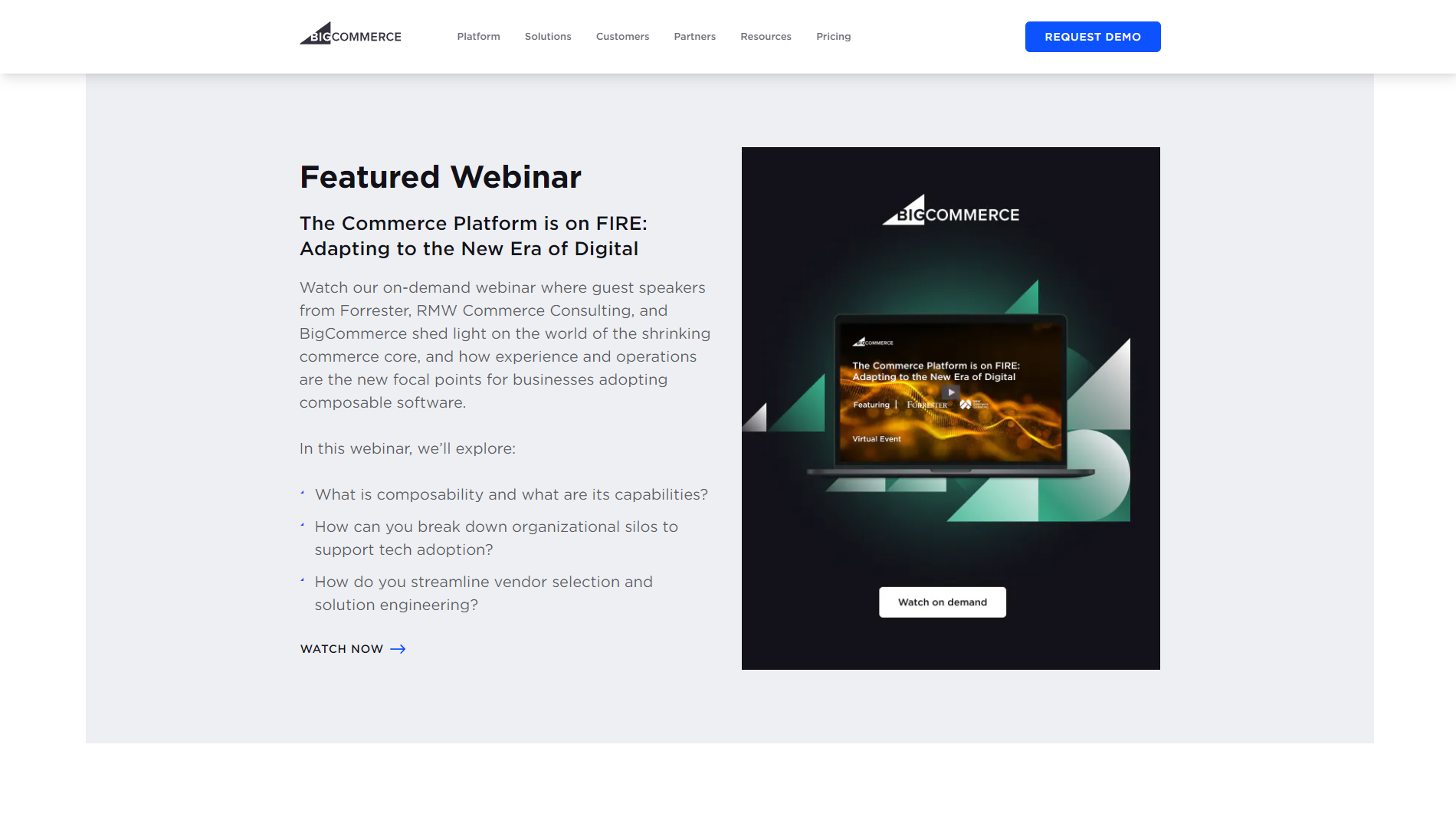
Source: BigCommerce
BigCommerce webinars include panel discussions from in-house experts, the latest trends in the ecommerce industry, and strategies for increasing sales across different platforms like TikTok or Facebook.
In addition to having the standard grid-style library of on-demand webinars, BigCommerce also has a featured webinar that it promotes at the top of its landing page. The description for featured webinars includes a list of guest speakers/companies and a concise agenda in the form of three bullet points.
You'll also find that BigCommerce is quite selective about which guest speakers they enlist to host certain webinars. For instance, their webinar on Sell Where Your Customers Are With a Social Commerce Strategy was hosted by Meta's Business Product Marketing Lead, Nathan Lam.
10. Adobe
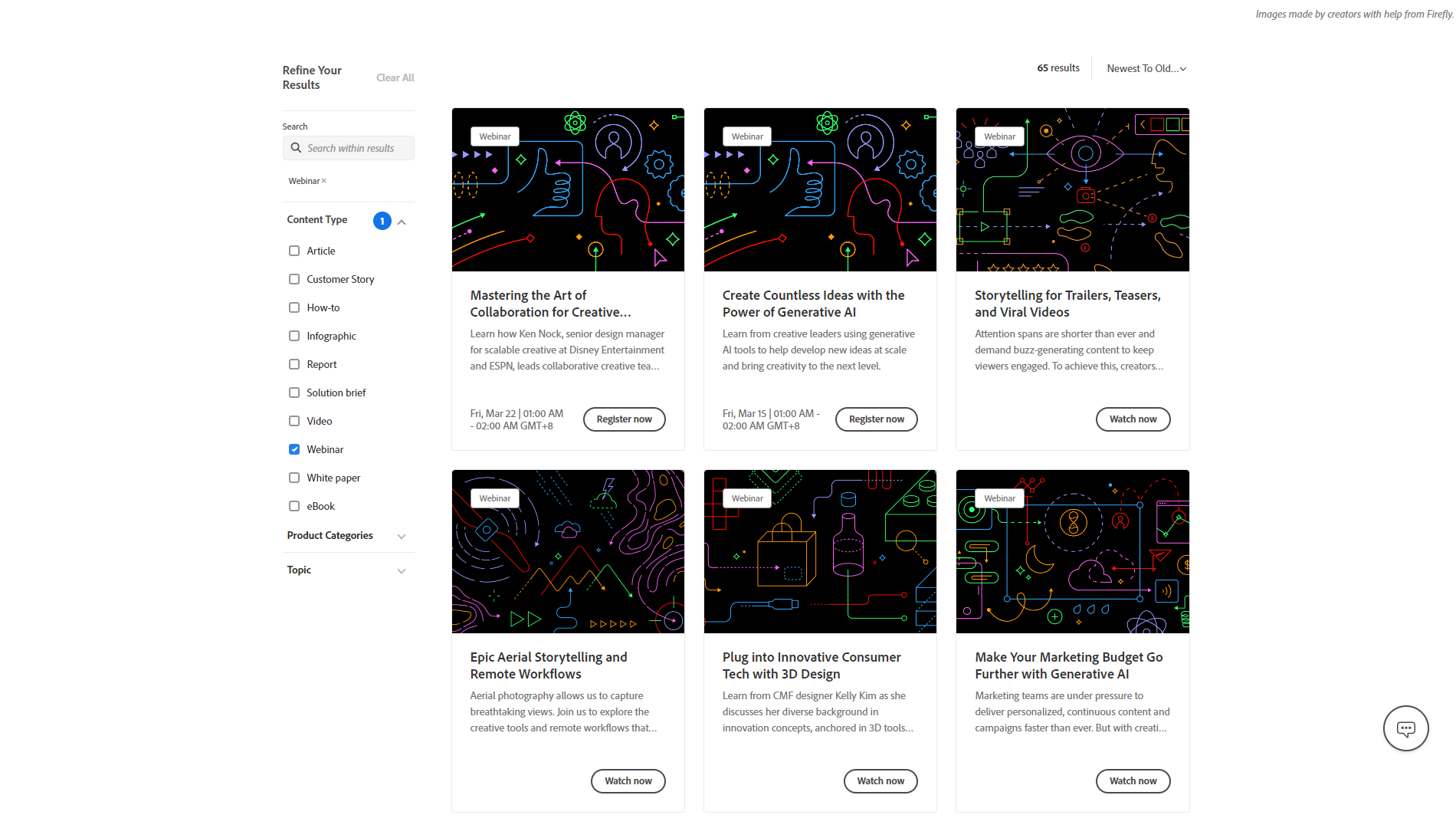
Source: Adobe
Adobe's webinar strategy reflects its diverse product offerings — under the Adobe Creative Cloud banner — by offering presentations on graphic design, video editing, and other adjacent topics. There are even webinars on marketing, storytelling, and artificial intelligence.
Despite the broad array of coverage from Adobe webinars, each presentation shares a unified identity thanks to the distinct style in their thumbnails. In addition to hosting live webinars on a weekly basis, Adobe also offers on-demand access to over 60 webinars at the time of writing.
Because Adobe's webinars cover both graphic design and video editing, it's very easy to organically integrate products like Photoshop or Premiere Pro into the presentation without it coming off like a sales pitch.
11. Hootsuite
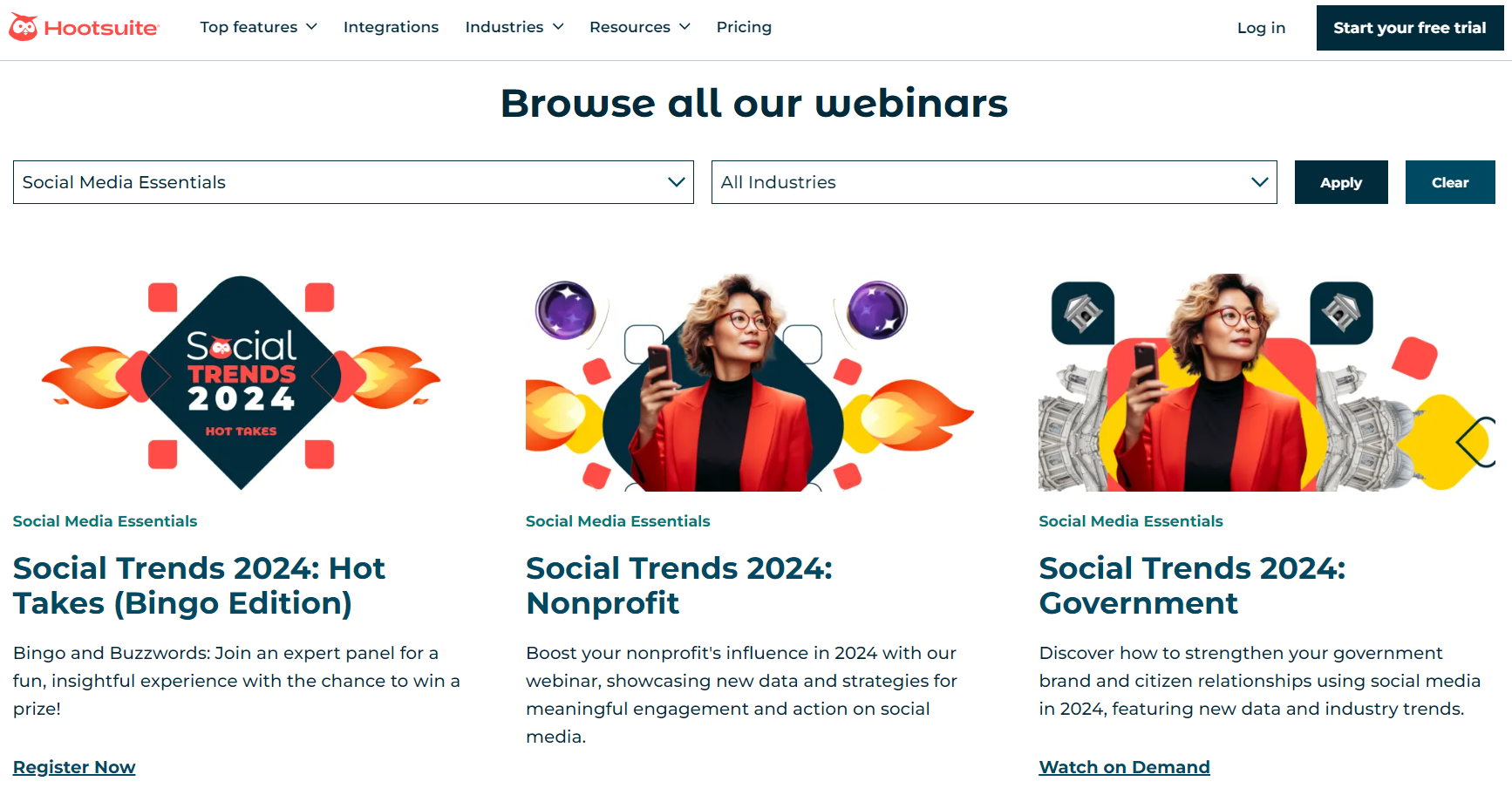
Source: Hootsuite
Hootsuite's webinars focus exclusively on social media — which makes sense since Hootsuite is a social media management tool. This positions them as an authority on one specific niche and ensures their webinars attract attendees from their target audience.
Hootsuite offers both live webinars that visitors can register for and on-demand presentations that attendees can watch immediately. While Hootsuite does let you filter by industry, some categories don't return any results (but may be reserved for future webinars that are still in the works).
Most recent Hootsuite webinars focus on the latest trends on social media platforms across different industries. However, there are also how-to presentations about managing crises on social media, engaging students, and career positioning.
Hootsuite even has a "Supercharge your social media strategy" webinar hosted by their VP of Marketing.
12. Sprout Social
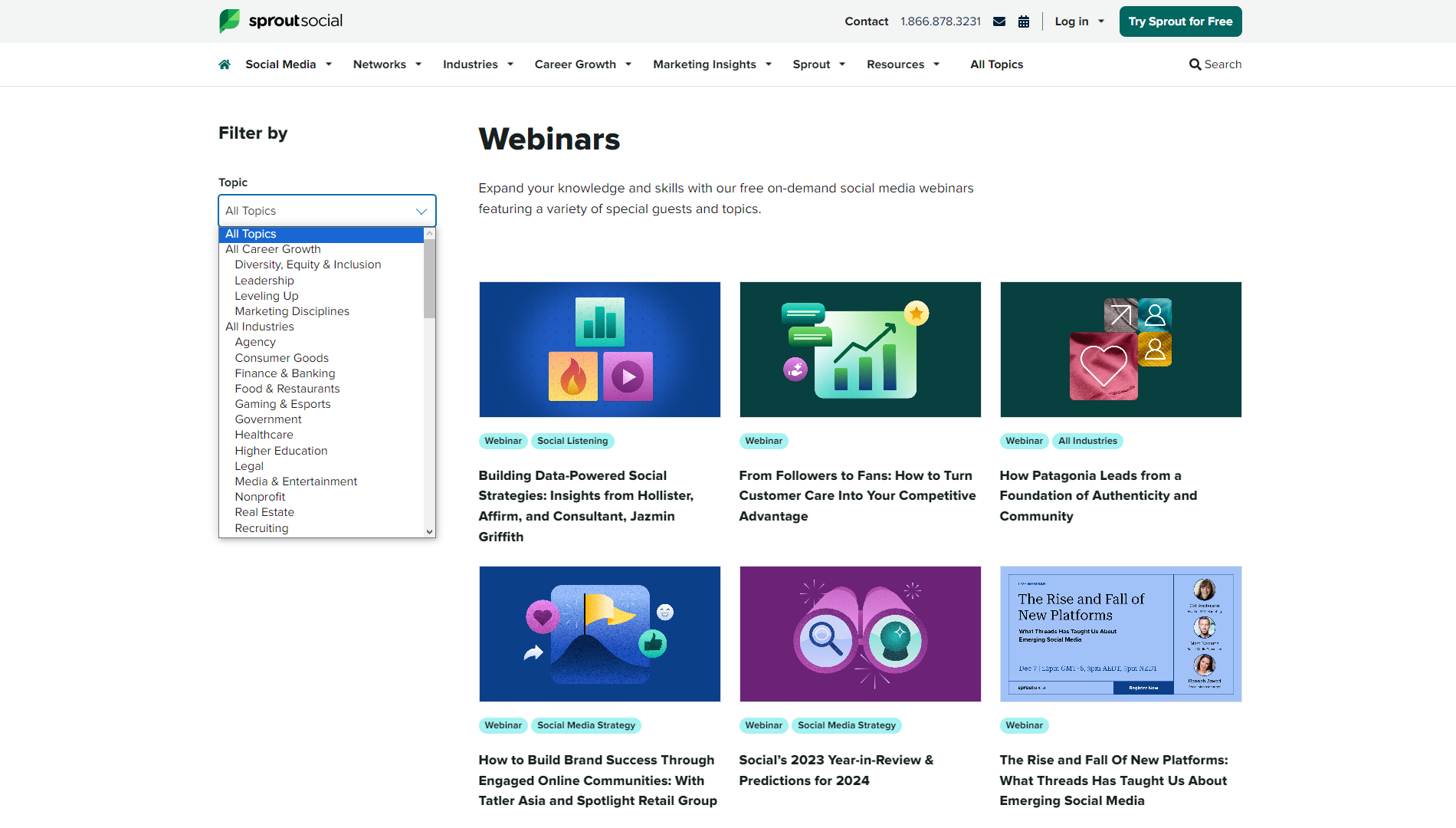
Source: Sprout Social
Sprout Social's webinars case studies of specific companies, postmortems on failed social media platforms, and trends/predictions around the ever-changing digital landscape. There are even presentations breaking down the latest Sprout Social Index (a report the company publishes each year).
Sprout Social also hosts special webinars annually with the most recent one being Social’s 2023 Year-in-Review & Predictions for 2024. These yearly presentations are essentially the digital equivalent of in-person events that happen annually like Social Media Marketing World.
The key difference is that Sprout Social's webinars are totally free to attend while tickets to annual conferences like SMM World can cost up to two grand. Finally, Sprout Social's topical filter helps registrants find the webinars that are most relevant to their line of work or personal interests.
13. Everest Group
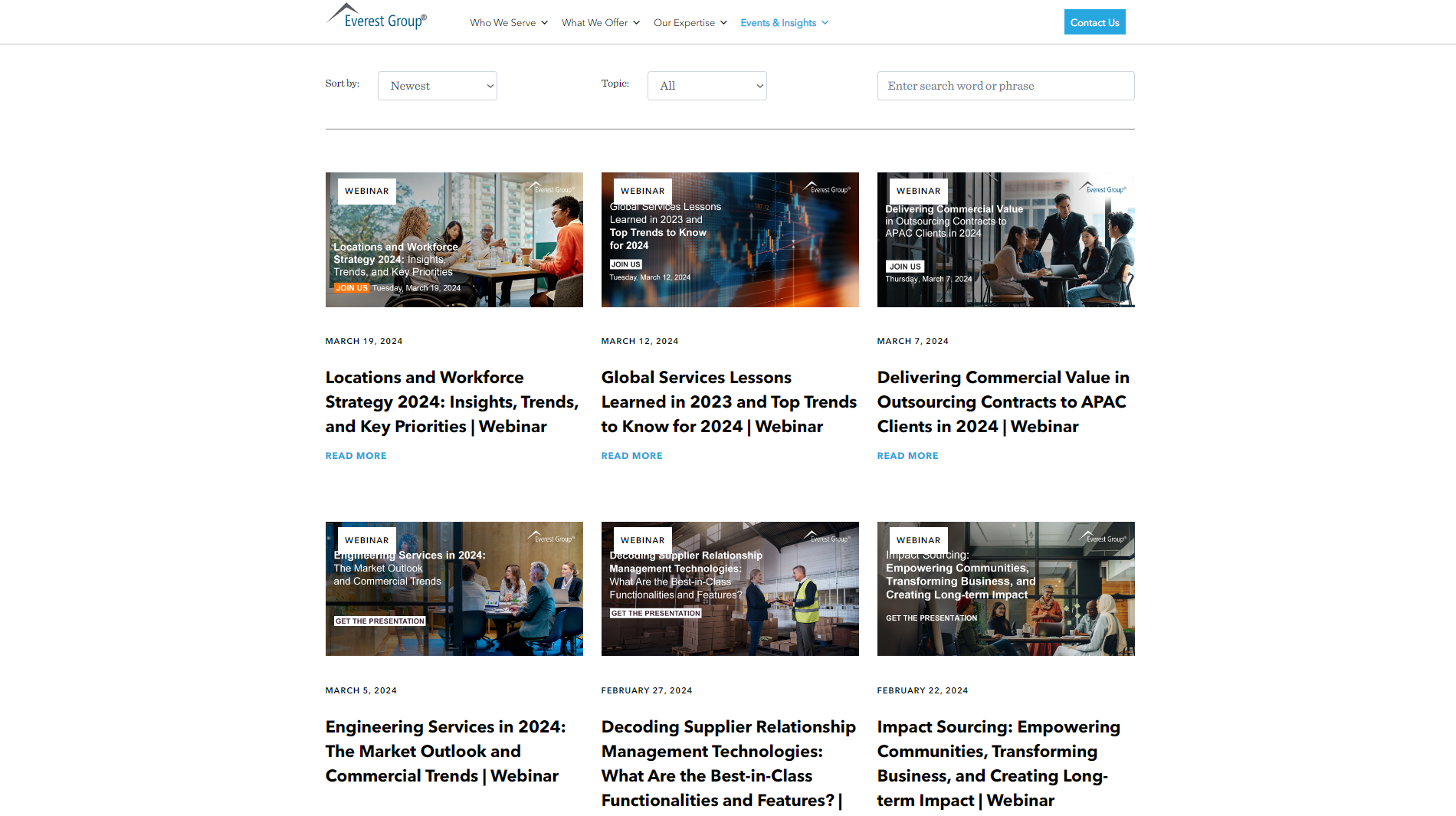
Source: Everest Group
Everest Group is a leading global BPO research firm that has been hosting two to three webinars per month since 2010. Historically, these were live events that you'd have to register for ahead of time and couldn't rewatch if you missed it.
Nowadays, Everest Group offers on-demand access to the replays of their recent webinars. In fact, there are over 50 webinars available in their library at the time of writing — each with a contact form attached to capture leads or answer attendee questions asynchronously.
Everest Group's webinars include recent trend coverage from multiple industries as well as instructional presentations on a myriad of business topics. Because their target audience consists primarily of executives, their webinars also leverage the expertise of multiple hosts who take turns presenting.
14. eWebinar
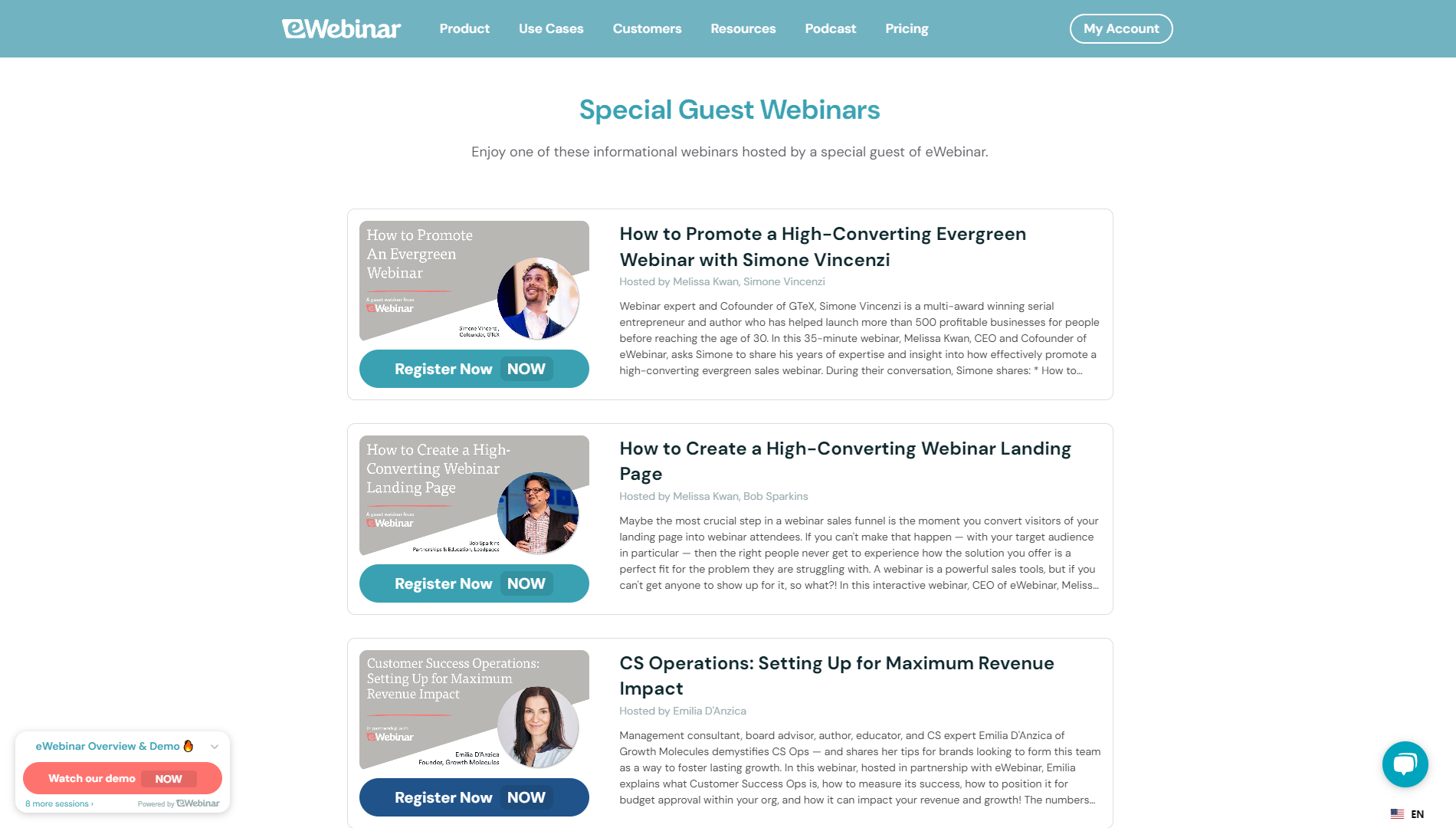
Browse our full webinar library here!
eWebinar is the webinar platform that Jon Schumacher used to triple his conversion rate and Later used to scale their attendance sixfold. That said, it's finally time to show you our own webinar library — which includes product demos, best practices, and guest presenters.
You'll notice that we've also included a floating widget on the bottom left corner of the screen so visitors browsing our library can join our demo instantly or register for an automated session scheduled later that day/week.
All the presentations in the eWebinar library — whether from us or our special guests — were created using our own webinar software. This means the hosts producing them were able to insert interactive elements that make the presentation more interactive than a live webinar.
Don't believe us? Just see for yourself when you watch our on-demand demo!
Conclusion
We hope these examples offer the inspiration and motivation needed to ensure your next webinar is a success. By following the best practices above and taking notes from the curated examples on this list, you're bound to run a successful event.
If you want to experience how a pre-recorded webinar with interactive features can keep the audience engaged then watch our on-demand demo!










